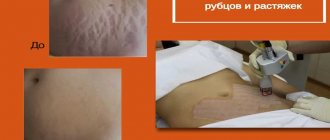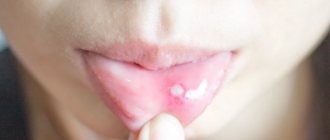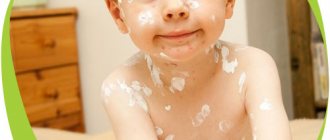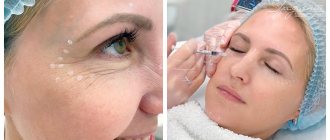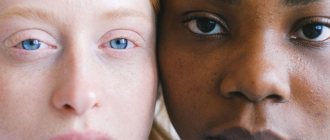Causes
The main reason for the appearance of red dots is burst blood vessels, which on the face are located very close to the surface of the skin .
This phenomenon cannot be considered serious, since due to such a superficial location, even minimal external influence or small pressure surges are enough for petechiae to occur.
Keep in mind! Bruises and insect bites are also considered non-pathological causes.
But this is only in cases where such effects do not lead to serious damage to the integrity of the skin and do not cause allergic reactions.
Other reasons for the formation of red dots in the eye area are:
- severe attacks of nausea and coughing, causing a sharp increase in blood pressure;
- avitaminosis;
- leukemia (a malignant disease of the hematopoietic system, which the common people mistakenly call “blood cancer”);
- renal failure;
- dermatological diseases of various types;
- allergic reactions;
- irritation due to the use of inappropriate cosmetics;
- hypoxia (lack of oxygen in skin tissues);
- exposure to strong winds, ultraviolet radiation or sudden changes in temperature;
- seborrheic dermatitis;
- eczema;
- stress and nervous exhaustion, provoking the development of inflammatory processes in the vascular system.
Note! In some patients, this symptom is a side effect of taking anticoagulant drugs.
Some medications impair blood clotting, as a result of which the vessels cannot cope with the increased blood flow against this background and petechiae occurs.
Hemangiomas in children
My one-and-a-half-year-old patient had a bruise under his eye.
- Where is he like that? Fell? - I asked. Unfortunately, being a pediatrician involves a certain amount of suspicion. “It’s not a bruise, he didn’t fall,” my mother answered tiredly. -Have you forgotten again? He has had this since birth, a hemangioma. I was confused. I had seen the boy once or twice before and, to be honest, had already forgotten about his peculiarity.
Taking a closer look, I was convinced that it was really not a bruise. A slightly convex, nodular formation clearly protruded above the surface of the skin. Its edges were uneven and seemed to consist of several small islands.
Infantile hemangiomas are benign vascular tumors growing from the endothelium. Hemangiomas come in various sizes - from millimeter to huge segmental ones, covering almost half of the head. The color of hemangiomas is usually red or bluish. Most often they occur on the head and neck, but can be on any part of the skin, mucous membranes and even on internal organs. Differential diagnosis must be made with other vascular formations.
There are single and multiple hemangiomas. Superficial, deep and combined hemangiomas are also distinguished.
What treatment is necessary and in what cases?
If the red dots are the result of insect bites, symptomatic treatment is required in exceptional cases when a person develops severe allergic reactions.
Also, therapy is not needed if such a symptom is
a consequence of nervous overstrain - it is enough to normalize your work and sleep schedule , and over time the skin condition will normalize.
In cases of pathological petechiae, treatment will be determined by the origin of the red dots.
In extremely rare cases (for example, with seborrheic dermatitis and abscesses ), surgery may be required to remove necrotic tissue and blood vessels.
But more often the cause of petechiae is an allergy, in which case treatment with antihistamines is required .
Stay up to date! As external remedies for allergies, you can use ointments and drops of Allergodil, Fenistil, Celestoderm, Actovegin, Actiderm, Forocort.
to supplement such therapy . If you have problems with blood vessels, it is better to choose multivitamin complexes containing calcium, zinc and vitamins E and A.
have a complex effect :
- Advantan . Anti-inflammatory ointment that helps with allergies and eliminates irritation, itching and burning. The drug contains no potent components. And despite the fact that this is a glucocorticosteroid drug, which has serious contraindications, in the absence of them, in most cases the cream is well tolerated by patients.
- Radevit . A symptomatic remedy that soothes itching, also has a moisturizing effect and helps to activate regenerative processes in facial skin cells. It is possible to use Radevit for mild manifestations of allergies.
- Momat. Another glucocorticosteroid cream that relieves inflammation and can be used to treat seborrheic dermatitis and any dermatoses in the initial stages.
- Gistan . An antiallergic drug that is sold in the form of an ointment for external use and in capsules for oral administration.
- Lokoid. Ointment for the treatment of many skin lesions of non-infectious origin. Among other things, it can be used to speed up the elimination of red dots).
- Traumeel. For burst blood vessels around the eyes, the drug is prescribed to be used in the form of an ointment. The product penetrates through the skin into the walls of blood vessels, restoring and strengthening them.
Symptoms
The main and most obvious symptom of the pathology is a rash. Most often, rashes appear on the head, chest, back, groin, armpits, and buttocks. The rash appears as scattered blisters with clear, white or yellow contents, or as small grains with an inflammatory outline.
During the day, the rash may intensify or decrease, and the severity of its manifestation depends on changes in temperature and care for the baby’s skin. In some cases, the child does not show concern, but sometimes may experience itching, pain and demonstrate discomfort with whims, unstable sleep, and lack of appetite.
In mild forms of the disease, other symptoms may not occur. But in more advanced cases, which are accompanied by complications and infection, clinical manifestations may be supplemented by:
- elevated temperature up to 38 degrees;
- the appearance of light plaque, ulcers, ulcers;
- the formation of weeping cracks with an unpleasant odor;
- general deterioration of condition.
When assessing symptoms, it is important to prevent the development of advanced forms of prickly heat and consult a doctor promptly, without waiting for complications to develop. Source: Skin care for a newborn. Solntseva O.A. Medical Council, 2014. p. 35-39.
Causes of urticaria
As soon as the hypothalamus registers an increase in body temperature in the brain, it sends an impulse to neurons that activate the sweat glands. Neurons release acetylcholine, which stimulates the release of histamine and heparin from mast cells in the skin (mast cell degranulation). This degranulation results in a diffuse release of histamine near the sweat glands. Histamine activates an inflammatory response in surrounding tissues and causes itching and redness. When you sweat (which is difficult for people with cholinergic urticaria), the skin reaction stops.
Chronic stress and nervousness can trigger an attack of psychosomatic urticaria. When constantly anxious, the body releases higher amounts of cortisol and adrenaline (stress hormones). But when the body is constantly in a state of tension and hormones continue to be released into the bloodstream, hormonal imbalance occurs. Adrenaline and cortisol combine with mast cells in the skin to produce histamine. Elevated levels of cortisol in the body cause allergic skin reactions such as hives and may even slow down healing.
Urticaria is usually a consequence of an allergic reaction in children when the body is exposed to the following allergens:
- pollen of flowering plants;
- house dust (dust mites);
- pet hair;
- some preservatives;
- Food.
Hives can also occur when a child wears clothes that are too tight and made from irritating materials such as polyester. It can also be caused by infections caused by bacteria, viruses or other microorganisms.
Some medications, such as ibuprofen, can cause hives in children as a side effect. Also, such a reaction can occur if the child has an individual intolerance to one or another substance included in the medicine. Most often these are antibacterial and non-steroidal drugs.
If children are suddenly exposed to large temperature fluctuations, hives may result. Likewise, prolonged exposure to the sun or cold can cause a similar skin reaction. In rare cases, urticaria can develop due to diseases such as leukemia and lymphoma. This happens because the immune system is weakened.
Hives in children can also be caused by insect bites, which can lead to significant swelling. If it's a mosquito or spider bite, sensitive skin may respond by releasing histamine, which causes hives. Contact with various viruses or bacteria can cause a diffuse rash. Reddened plaques can be observed throughout the body.
Treatment
The main method that allows you to remove rashes and cure skin pathologies is hygienic care. It is important to change the diaper immediately after a bowel movement and every three hours, washing the baby with running water. Between shifts you need to give air baths and leave the baby without clothes for a few minutes. At the same time, it is necessary to abandon synthetic clothing and low-quality children's cosmetics.
Bathing is carried out in water with a decoction of medicinal herbs. You can add chamomile, yarrow, and string. After bathing the child, dry thoroughly and powder the skin with powder.
In some cases, the doctor also prescribes treatment of rashes with drying antiseptics (“Furacilin”, “Chlorphilipt”), and creams containing panthenol (“Bepanten”, “Dexpanthenol”). White, red and deep miliaria are treated with antifungal and antibacterial ointments. However, it is not recommended to use any medications without prior consultation with a doctor. Source: Modern dermatological and cosmetic products for caring for the skin of children. Kotlukov V.K., Kuzmenko L.G., Antipova N.V. Medical Council, 2013. p. 8-12.
Doctors recommend setting the air temperature in the nursery at 20-22 degrees and monitoring the humidity, which should not exceed 50-70%. A good solution would be to purchase an air humidifier that will help create the right microclimate. These simple steps can help you get rid of the conditions that increase your risk of developing heat rash.
Prevention
Effective prevention consists of proper and thorough hygienic care of the child: regular bathing, frequent changing of diapers or diapers. During the hot season, you can bathe your baby up to 2-4 times a day, but it is important not to use soap, oils, lotions and other products with each water procedure that can disrupt the acid balance and clog the glands.
It is also important to select clothes from natural, breathable fabrics and avoid synthetic and semi-synthetic fabrics that do not ensure normal evaporation of sweat. You need to dress your baby appropriately for the weather and not wrap him up in a warm blanket on a summer night. Source: Skin care for infants. Prevention of diaper dermatitis. Starostina L.S. Medical Council, 2022. p. 41-49.
Sources:
- Skin care for infants. Prevention of diaper dermatitis. Starostina L.S. Medical Council, 2022. p. 41-49
- Newborn skin care. Solntseva O.A. Medical Council, 2014. p. 35-39
- Modern dermatological and cosmetic products for the care of children's skin. Kotlukov V.K., Kuzmenko L.G., Antipova N.V. Medical Council, 2013. p. 8-12
Date of publication: 10/20/2017
The information in this article is provided for reference purposes and does not replace advice from a qualified professional. Don't self-medicate! At the first signs of illness, you should consult a doctor.


